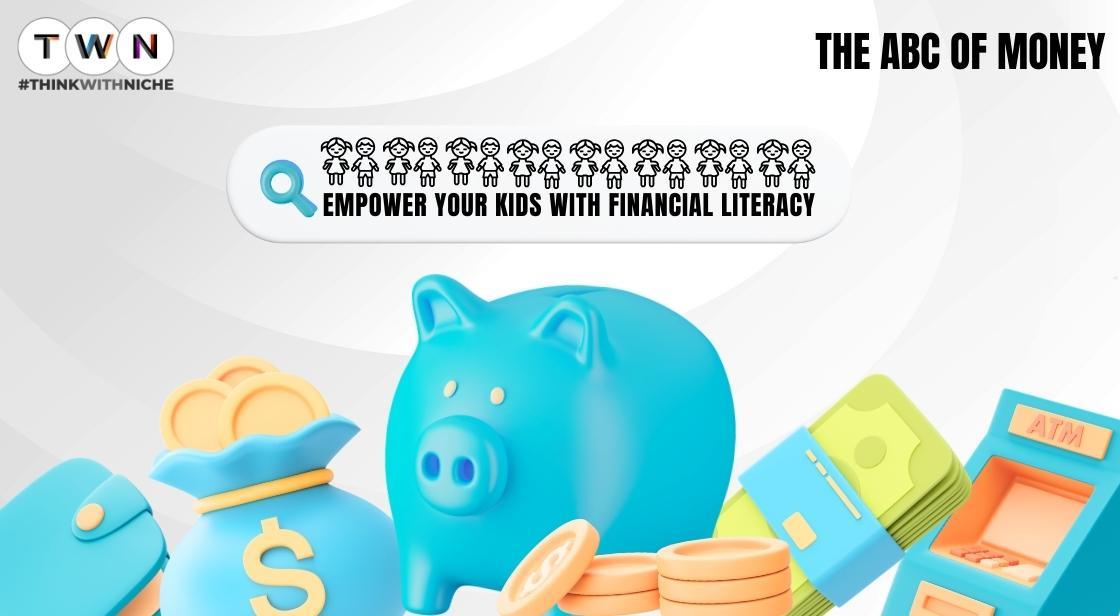Empower Your Kids with Financial Literacy: The ABC of Money

Blog Post
In today's fast-paced world, our children are quick learners, technologically adept, and remarkably observant. They swiftly acquire habits and develop a keen sense of needs, wants, and lifestyle preferences from a young age.
However, amidst this rapid learning, one crucial aspect often gets overlooked – the significance of saving and investing for a secure and prosperous future.
While some children may grasp the importance of investing, they frequently lack the knowledge of how and where to invest effectively. Consequently, they may either seek personal finance guidance or make investment decisions that aren't in their best interest.
Financial literacy extends beyond mere familiarity with basic financial terms; it encompasses the essential skills required to cultivate financial acumen. As parents, it falls upon us to instill robust financial competence in our children, equipping them with the tools they need to navigate the complex world of finance successfully.
The beauty of this endeavor is that you don't need to possess the financial prowess of a Wall Street tycoon to impart financial wisdom to your children. Instead, your role is to lay a sturdy foundation by providing them with perspective and nurturing the right financial habits.
In this article, we embark on a journey to explore the fundamentals of financial literacy.
Our goal is to empower you with the knowledge and strategies to educate your children in this critical life skill, ensuring they embark on a path towards financial well-being and a brighter future.
Financial literacy entails the capacity to comprehensively grasp and proficiently handle financial matters. It is an important skill for everyone to have, but it is especially important for children. By teaching your kids about money from a young age, you can help them develop healthy financial habits and build a secure financial future.
It is an important skill for everyone to have, but it is especially important for children. By teaching your kids about money from a young age, you can help them develop healthy financial habits and build a secure financial future.
Teaching your kids about money is one of the most important things you can do for their future. Here are some tips on how to get started.
Empower Your Kids with Financial Literacy: The ABCs of Money
How to teach kids about money
-
Start early
The earlier you initiate conversations with your children regarding finances, the more advantageous it is. Even young children can learn about basic concepts such as saving and spending. For example, you can start by teaching them about the different types of coins and bills, and how to count money. You can also teach them about the difference between needs and wants, and how to make choices about how to spend their money.
-
Make it fun
Learning about money doesn't have to be boring. There are many games and activities that can help kids learn about money in a fun and engaging way. For example, you can play games like Monopoly or Life, which teach kids about budgeting, saving, and investing. You can also read them books about money, or watch educational videos.
-
Be a good role model
Be mindful of your own spending habits and talk to your kids about your financial decisions. For example, if you're saving for a down payment on a house, talk to your kids about why you're saving money and how you're planning to reach your goal. This will help them understand the importance of saving money and making wise financial decisions.
-
Make it relevant
Connect financial lessons to your child's everyday life. For example, when you go to the grocery store, talk to your child about how much things cost and how to make a budget. You can also talk to them about how to choose between different brands of products and how to save money on coupons and sales.
Here are some extra suggestions for educating kids about finances:
-
Provide them with an allowance. Offering an allowance is an excellent method to instruct children in money management. When you provide your child with an allowance, have a conversation with them about how to handle their money. Assist them in establishing a budget and monitoring their expenses.
-
Encourage them to save money. Help your child set savings goals and develop a plan for reaching those goals. You can offer to match their savings or give them a bonus for reaching their savings goals.
-
Teach them about investing. Once your child understands the basics of saving money, you can start teaching them about investing. Explain to them what investing is and why it's important. You can also help them choose investments that are appropriate for their age and risk tolerance.
Teaching kids about money is an important part of preparing them for financial success in the future. By following the tips above, you can help your kids develop good financial habits and learn how to manage their money wisely.
1. Why Financial Literacy for Kids Matters
Financial literacy for kids is not just a nice-to-have skill; it's a critical aspect of their overall education and future success. Here's an expanded look at why teaching financial literacy to children is of paramount importance:
-
Foundation for Financial Independence: Early financial education lays the foundation for children to become financially independent adults. They learn the fundamental principles of money management, budgeting, and saving, which are essential skills in today's world.
-
Economic Uncertainty: In an era marked by economic uncertainties and rapidly changing financial landscapes, teaching kids about money becomes even more crucial. It equips them to navigate financial challenges and make informed decisions.
-
Debt Avoidance: Financially literate kids are more likely to avoid falling into the debt trap as adults. They understand the consequences of borrowing money and the importance of living within their means.
-
Critical Thinking and Problem-Solving: Learning about money encourages critical thinking and problem-solving. Children grasp the concept of making choices based on limited resources, a skill applicable to various aspects of life.
-
Career Success: Financial literacy extends beyond personal finance; it can impact career success. Kids who understand money are better equipped to negotiate salaries, manage workplace benefits, and plan for their retirement.
-
Globalization: In an increasingly globalized world, financial literacy is a global language. It enables children to comprehend international financial systems, exchange rates, and global economic trends.
The Importance of Early Financial Education
Early financial education provides children with a head start in managing their finances and making sound money decisions. Here are some compelling reasons why starting financial education early is essential:
-
Formative Years: The early years of a child's life are formative. They are more receptive to learning and are eager to absorb information. Starting financial education during this period ensures that money management concepts become ingrained in their thinking.
-
Behavioral Patterns: Children form behavioral patterns early on, including their attitudes towards money. Early financial education helps establish positive money habits that can last a lifetime.
-
Empowerment: Financial literacy empowers children. It gives them the confidence to ask questions about money matters and make informed choices.
-
Risk Management: Kids learn about risk management by understanding the consequences of their financial decisions. This skill becomes increasingly important as they grow and face more significant financial choices.
-
Math and Literacy Skills: Financial education complements math and literacy skills. It provides real-life contexts for mathematical concepts and enhances reading comprehension through financial texts.
-
Parental Involvement: Early financial education often involves parents or guardians. It fosters family discussions about money, reinforcing learning at home and in school.
Impact of Financial Literacy on Future Success
The impact of financial literacy in childhood reverberates throughout an individual's life, shaping their financial security, well-being, and success. Here's a closer look at the enduring effects:
-
Higher Earnings: Studies have shown that financially literate individuals tend to earn more over their lifetimes. They make informed career choices, negotiate better salaries, and manage their finances efficiently.
-
Better Financial Decision-Making: Financially literate individuals are less likely to make impulsive or risky financial decisions. They understand the long-term consequences of their choices and prioritize saving and investing.
-
Debt Management: Those with strong financial literacy skills are more adept at managing debt. They are less likely to accumulate excessive credit card debt or default on loans.
-
Entrepreneurial Endeavors: Financially literate individuals often have the confidence to explore entrepreneurial endeavors. They can create and manage businesses, contributing to economic growth.
-
Financial Security: Ultimately, financial literacy leads to financial security and peace of mind. It allows individuals to plan for retirement, emergencies, and long-term goals.
-
Community and Societal Impact: Financially literate individuals also have a positive impact on their communities. They are more likely to engage in charitable giving and support community initiatives.
Teaching Money Basics: Start with the Essentials
When it comes to teaching money basics to kids, beginning with the essentials is crucial. Here's an in-depth exploration of how to introduce children to the world of coins and currency:
-
Understanding Coins and Notes: Start by teaching kids about the different denominations of coins and currency notes. Show them real examples, such as pennies, nickels, dimes, and quarters for coins, and one-dollar, five-dollar, and ten-dollar bills for currency. Emphasize the unique features of each.
-
Counting and Sorting: Engage children in interactive activities like counting and sorting money. You can create simple games where they group coins of the same value together or count the total value of a handful of coins. This hands-on approach helps reinforce their understanding.
-
Identifying Symbols: Teach kids to identify the symbols and images on coins and notes. Explain the historical significance behind these symbols, such as the portraits of important figures and national landmarks. It's an excellent opportunity to blend history with financial education.
-
Value Recognition: Gradually, introduce the concept of value. Help children understand that different coins and notes represent varying values. Start with basic comparisons, like a nickel being worth more than a penny, and progress to more complex value recognition as they grasp the basics.
-
Role-Playing: Encourage role-playing scenarios where children pretend to be cashiers or customers in a store. Use play money or actual coins and notes to simulate transactions. This activity reinforces their knowledge of denominations and counting skills.
-
Savings Jars: Create savings jars or piggy banks labeled for different savings goals. Let kids deposit their spare change regularly. This practice instills the habit of saving and setting financial goals from a young age.
Also Read: Sustainability Strategies for Businesses: Tips for Going Green
Introducing Kids to the Concept of Earning and Spending
Teaching kids about earning and spending money is a fundamental part of their financial education. Here's how to introduce these concepts effectively:
-
Allowance System: Consider implementing an allowance system. Provide children with a regular allowance for completing age-appropriate chores or tasks. This mimics the idea of earning money through work and helps them understand the connection between effort and income.
-
Savings vs. Spending: Teach the importance of setting aside a portion of their earnings for savings before spending. Discuss short-term goals, like buying a toy, and long-term goals, like saving for a bicycle. This illustrates the value of delayed gratification.
-
Budgeting Lessons: Introduce budgeting concepts by helping kids plan how to allocate their allowance. Create a simple budget that divides their income into categories, such as saving, spending, and giving. Encourage them to track their expenses.
-
Shopping Trips: Take children on shopping trips and involve them in purchasing decisions. Compare prices and discuss the concept of making choices based on available funds. Encourage them to ask questions and think critically about purchases.
-
Needs vs. Wants: Differentiate between needs and wants. Teach kids that some expenses are necessary for survival (needs), while others are optional (wants). This distinction helps them make thoughtful spending choices.
-
Charitable Giving: Instill the value of giving back by involving kids in charitable activities. Let them choose a cause or organization to support with a portion of their allowance. This teaches empathy and generosity.
Budgeting for Kids: The Art of Saving and Spending
Teaching kids the art of budgeting is a valuable life skill that sets the stage for financial responsibility. Here's an in-depth exploration of how to create a simple budget for kids and encourage wise spending choices:
-
Start with an Allowance: Begin by providing children with a regular allowance. This allowance can be tied to age-appropriate chores or tasks, reinforcing the idea that money is earned through effort. Consider giving it in denominations that facilitate budgeting, such as dollar bills and coins.
-
The Three-Envelope System: A simple budgeting method for kids involves using three envelopes or jars labeled "Save," "Spend," and "Give." When children receive their allowance, guide them in dividing it among these envelopes based on a predetermined allocation. For example, they might decide to save 40%, spend 40%, and give 20% of their allowance.
-
Setting Savings Goals: Encourage kids to identify savings goals. Whether it's a new toy, a video game, or a special outing, having a goal helps them stay motivated to save. Discuss the cost of the item and calculate how long it will take to save for it, fostering patience and planning.
-
Tracking Income and Expenses: Teach kids to keep a simple record of their income (allowance) and expenses. This can be done with a basic ledger or notebook. Have them write down when they receive money and how much they allocate to each envelope. Similarly, record spending when they make purchases.
-
Making Wise Spending Choices:
-
Price Comparison: When shopping for toys, games, or treats, involve kids in the decision-making process. Encourage them to compare prices and consider the value of items. Discuss how they can get more for their money by choosing wisely.
-
Needs vs. Wants: Reinforce the concept of distinguishing between needs and wants. Help children understand that some purchases are essential (needs), like groceries, while others are optional (wants), like a new video game. This helps them prioritize spending.
-
Delayed Gratification: Emphasize the importance of delayed gratification. If a child wants a costly item, discuss the idea of saving for it rather than making an impulsive purchase. This cultivates patience and discipline.
-
Opportunity Cost: Teach kids about opportunity cost, the idea that choosing one thing means giving up something else. For instance, if they spend their entire "Spend" envelope on a toy, they won't have funds left for other potential purchases or savings goals.
-
-
Giving Back: Incorporate a charitable component into their budget. Allocate a portion of their allowance to the "Give" envelope, and together, select a cause or organization to support. Discuss the impact of their generosity on others.
-
Review and Adjust: Periodically review their budget and financial goals together. This provides an opportunity to celebrate achievements, make adjustments, and set new goals. It also reinforces the habit of actively managing finances.
The benefits of saving money
Saving money has many benefits for kids, including:
-
It teaches them the importance of delayed gratification. When kids save money for a goal, they learn that they can't always have everything they want right away. They also learn that waiting for something can make it even more rewarding.
-
It helps them develop financial discipline. When kids have to make decisions about how to spend their money, they learn to be more mindful of their spending habits. They also learn to make sacrifices in order to reach their financial goals.
-
It teaches them the value of money. When kids see how their savings grow over time, they learn that money is not something to be taken for granted. They also learn that money can be used to achieve their goals.
-
It gives them a sense of security. Knowing that they have money saved up can give kids a sense of security and financial independence. This can be especially important in difficult times.
Setting savings goals for kids
One of the best ways to help kids save money is to help them set savings goals. Having a specific goal in mind will help them stay motivated to save.
Here are some tips for setting savings goals for kids:
-
Make the goals realistic and achievable. The goals should be challenging but not impossible to reach.
-
Break down the goals into smaller steps. This will make them seem less daunting and more achievable.
-
Tie the goals to something that your child is interested in. This will help them stay motivated to save.
-
Celebrate successes along the way. This will help your child stay on track and motivated.
Opening a bank account for your child
Opening a bank account for your child is a great way to help them learn about saving money and managing their finances.
Here are some of the benefits of opening a bank account for your child:
-
It teaches them about the banking system. When kids have their own bank account, they learn about different types of accounts, how to deposit and withdraw money, and how to write checks.
-
It helps them develop a credit history. When kids start saving money in a bank account, they start building a credit history. This can be beneficial when they apply for loans or credit cards in the future.
-
It gives them a sense of responsibility. Having their own bank account gives kids a sense of responsibility for their own money. This can help them develop good financial habits that will last a lifetime.
When choosing a bank account for your child, be sure to consider the following factors:
-
Fees: Some banks charge monthly fees for bank accounts, especially for accounts with low balances. Be sure to compare fees before choosing a bank account for your child.
-
Interest rates: Some banks offer interest on savings accounts. This means that your child's money will grow over time. Look for a bank account that offers a competitive interest rate.
-
Features: Some bank accounts offer features such as debit cards, online banking, and mobile banking. Consider which features are important to you and your child when choosing a bank account.
Examples of savings goals for kids:
-
Saving for a new toy or game
-
Saving for a new bike
-
Saving for a vacation
-
Saving for college
-
Saving for a down payment on a house
Investing for the Future: Making Money Work for Them
Investing is the process of using money to buy assets with the expectation that they will increase in value over time. Investing can be a great way to grow your wealth and reach your financial goals.
Introducing kids to the concept of investments
It's never too early to start teaching kids about investing. Even young children can understand the basic concepts of investing, such as saving money and buying things that can grow in value over time.
Here are some tips for introducing kids to the concept of investments:
-
Talk to them about money. Explain to your kids what money is and how it can be used. Talk to them about the difference between saving money and spending money.
-
Help them set savings goals. Once your kids understand the importance of saving money, help them set savings goals. This could be saving for a new toy, a new bike, or college.
-
Teach them about different types of investments. There are many different types of investments, such as stocks, bonds, and mutual funds. Explain to your kids the basics of each type of investment and how they work.
-
Show them how to invest. Once your kids understand the basics of investing, show them how to invest their own money. This could be by opening a custodial brokerage account or by investing in a mutual fund through a college savings plan.
Teaching the importance of long-term savings
One of the most important things to teach kids about investing is the importance of long-term savings. The earlier you start investing, the more time your money has to grow.
Here are some tips for teaching kids the importance of long-term savings:
-
Explain the power of compound interest. Compound interest is interest that is earned on both the principal investment and the accumulated interest. Over time, compound interest can cause your money to grow exponentially.
-
Show them how long-term savings can help them reach their financial goals. For example, if they start saving for college early, they may be able to graduate debt-free.
-
Help them stay motivated. Long-term savings can be challenging, but it's important to help kids stay motivated. Talk to them about their financial goals and remind them why they're saving money.
Examples of investments for kids:
-
College savings plans: College savings plans, such as 529 plans and Coverdell Education Savings Accounts (ESAs), offer tax advantages and can help kids save for college.
-
Custodial brokerage accounts: Custodial brokerage accounts allow parents to invest money on behalf of their minor children.
-
Mutual funds: Mutual funds are a type of investment that pools money from many investors to buy a basket of stocks, bonds, or other assets.
-
Index funds: Index funds are a type of mutual fund that tracks a specific market index, such as the S&P 500. Index funds are a good way to invest in the stock market with low fees.
Age-appropriate financial lessons
Toddlers
-
Introduce basic concepts such as money, saving, and spending.
-
Help them identify different types of coins and bills.
-
Show them how to count money.
-
Talk to them about the difference between needs and wants.
-
Let them help you make simple purchases, such as paying for groceries or buying a toy.
Examples:
-
When you go to the grocery store, point out the different types of coins and bills to your child. Show them how to count the money and pay for the items you are buying.
-
When you are shopping for a toy, talk to your child about the difference between needs and wants. Explain that needs are things that we must have, like food and clothing. Wants are things that we would like to have, but we don't need them. Help your child make a decision about whether or not the toy is a need or a want.
-
Give your child a small allowance each week. Help them create a budget for their allowance and track their spending.
Preschoolers
-
Teach them how to count money and make simple purchases.
-
Help them understand the value of money.
-
Talk to them about the importance of saving money.
-
Encourage them to set savings goals.
Examples:
-
When you are at the store, give your child a small amount of money to pay for a small item, such as a candy bar or a sticker.
-
Talk to your child about the value of money. Explain that money can be used to buy things that we need and want.
-
Help your child set a savings goal, such as saving for a new toy or a book. You can open a savings account for your child and help them deposit their money on a regular basis.
Elementary school children
-
Teach them about budgeting, saving for goals, and investing.
-
Help them learn how to make wise financial decisions.
-
Talk to them about the importance of giving back to the community.
Examples:
-
Help your child create a budget for their allowance or other income. Show them how to track their spending and make sure that they are not spending more money than they have.
-
Talk to your child about the importance of saving money for goals. Help them set specific savings goals and develop a plan for reaching those goals.
-
Introduce your child to the concept of investing. Explain what investing is and why it's important. You can also help them choose investments that are appropriate for their age and risk tolerance.
-
Talk to your child about the importance of giving back to the community. There are many ways that kids can get involved in philanthropy, such as volunteering their time or donating to a charity.
Middle school children
-
Teach them about credit cards, interest rates, and loans.
-
Help them understand the importance of good credit.
-
Talk to them about the dangers of debt.
Examples:
-
Explain to your child how credit cards work and how interest rates are calculated.
-
Talk to your child about the importance of good credit and how it can help them in the future, such as when they apply for a loan or a mortgage.
-
Warn your child about the dangers of debt and how it can be difficult to get out of.
High school students
-
Teach them about taxes, insurance, and retirement planning.
-
Help them prepare for a financially secure future.
Examples:
-
Explain to your child how taxes work and how to file a tax return.
-
Talk to your child about the importance of insurance and how it can protect them from financial losses.
-
Introduce your child to the concept of retirement planning. Explain what retirement planning is and why it's important. You can also help them choose investments that are appropriate for their retirement goals.
Teaching your kids about money is one of the most important things you can do for their future. By starting early and teaching them age-appropriate financial lessons, you can help them develop good financial habits and make wise financial decisions throughout their lives.
Conclusion:
Empowering your children with financial knowledge is a gift that will last a lifetime. By teaching them the ABCs of money from an early age, you're giving them the tools they need to make informed financial decisions and achieve financial success in adulthood.
Start their financial education journey today, and watch them flourish as financially savvy individuals, Financial literacy for children is a wise investment in their future.
It equips them with the skills and knowledge needed to navigate the complex financial world, make informed decisions, and achieve financial success and security throughout their lives.
You May Like
EDITOR’S CHOICE












